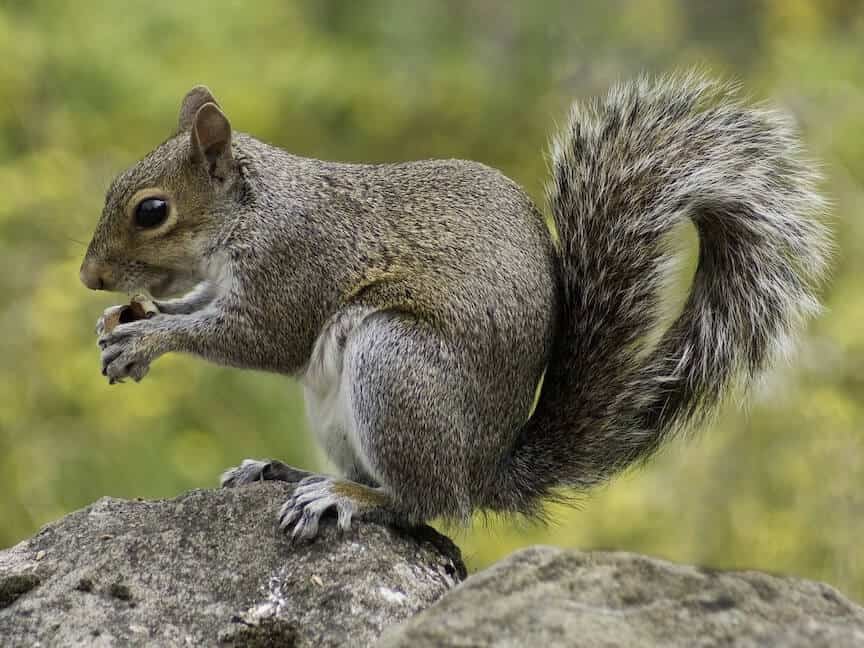Many would agree that squirrels can be quite fun to watch. But, when these animals get into places they shouldn't, they can cause a lot of problems. Here are a few squirrels you can expect to find on your Missouri property.
Fox Squirrel (Sciurus Niger)
The fox squirrel, also known as the eastern fox squirrel or Bryant's fox squirrel, is the largest species of tree squirrel native to North America. It has very sharp claws, a muscular body, and a long, fluffy tail. The most common fur color for a fox squirrel is reddish-brown, but color can vary greatly from overall pale gray to black with white feet. But the fur on its belly is always lighter in color than the rest its body. Often a fox squirrel will have reddish hairs tipped with brown, this gives them a frosted look, very pretty if you are a squirrel fan. These animals are most often found in forests with open understory, or in urban neighborhoods with trees. They prefer to live among oak, hickory, walnut and pine trees, storing their nuts for winter. They shelter in leaf nests or tree dens, but will sometimes make an attic their home if they find a way inside.
Gray Squirrel (Sciurus Carolinensis)
Native to eastern North America, the gray squirrel, or eastern gray squirrel is a medium sized tree squirrel where the males and females are similar in size and color. Their back fur ranges from a pale gray to a grizzled dark gray that may have red tones. A gray squirrel's ears, tail, and underparts are pale gray to white but some populations of eastern gray squirrels are entirely melanistic so that all squirrels in a particular area are completely black. Like most squirrels, this animal is a hoarder. It stores away food in numerous small caches to be eaten later. It is estimated that each squirrel that hoards will make several thousand caches each season, some being very temporary, and others where they will store food for months. These squirrels build nests called "dreys" in the forks of trees which consist mainly of dry leaves and twigs.
Red Squirrel (Tamiasciurus Hudsonicus)
A red squirrel, or, in this case, an American red squirrel is also known as a pine squirrel, North American red squirrels, boomers, and chickarees (probably because of the noises they make). These are medium-sized diurnal mammals that stick to the same territory year round, defending it. Smaller than other squirrels, they have reddish or olive gray backs and white undersides with dark lines that are most easy to see in the summer months. The tail of a red squirrel is smaller and flatter than that of other squirrels and can be a rusty red or yellowish gray with a black band along it. Their bellies are white or cream, and males and females look very similar. A red squirrel will get all new fur on its body two times a year, and once a year on its tail. This helps people who study these animals to be able to tell how old they are. Unlike other squirrels with a wide variety of foods in their diets, American red squirrels focus on the seeds of conifer cones, which means they are common wherever these trees are abundant.
Southern Flying Squirrel (Glaucomys Volans)
The southern flying squirrel, also called the assapan, is the only flying squirrel found in North America. It is easily identified by the gliding membrane or flap of loose skin that runs from the animals wrists to its ankles. It's soft back fur and tail fur are gray, and its underside is white. These fascinating creatures are found in woodlands and prefer seed-producing hardwood trees such as maple, beech, hickory, oak, and poplar. They eat a wide range of foods including nuts, acorns, seeds, berries, fruit, moths, Junebug's, eggs, and even young birds or mice. Contrary to their name, flying squirrels do not actually fly, they glide.
If you are having issues with any of these squirrels being destructive on your property or getting into your attic spaces and wall voids, contact Rottler Pest & Lawn Solutions for an immediate resolution to the problem.


